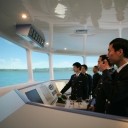Heavy Weather Ballasting Procedures/Guidelines for M.T. New ConXXXXX
Scope;
• The Scope of these procedures is to enable facilitation and easy handling of the Ballast system on board “M.T New ConXXXXX”
• The Procedures are Prepared after taking into account the guidelines provided by the Vessels Operator/Owners via the Letter to Master( 06-02), Information Provided by the vessels Builder , Procedure and Arrangement Manual, Crude Oil washing system Manual, SMPEP, System Drawings & Trim and Stability Booklet, Ballast Management Plan.
• Attachments include Line arrangement, Calculation Results from Loadicator (Cargo Max), Trim and Stability Booklet results (For Heavy Weather ballast)
Brief Description & General Lay Out of the Ballast system;
New CoXXXXXX Ballast system consists of 17 Tanks in the cargo area namely 1(P&S), 2(P&S), 3(P&S), 4(P&S), 5(P&S), 6(P&S), 2(**), 3(**), 4(**), 5(**), Fore-Peak.
The other tanks consist of APK connected to the Vessels Fire and General Service system.
The Ballast Tanks are served by two electrically driven Centrifugal Pumps with a capacity of 1,500m3/hr @ 0.45 Mpa through two 450mm ballast lines. These Lines branch into the respective tanks.
The Stripping system is
• Eductor system, two in number, Capacity 200m3/hr each. The driving water is supplied by main ballast Pump (s) and the requirement is 830 m3/hr or fire pump.
• Vacuum Self Priming system which is connected to the Ballast Pumps and activate automatically when in auto mode (Controls in Engine Room). These vacuum Pumps ensure a vacuum of 600mm/Hg and cut in (start) when the vacuum drops below 600mm/Hg.
Emergency Systems (Lay-out and Description)
The Emergency System for ballast consists of;
• Emergency Ballasting arrangement for Cargo Tanks.
• De-Ballasting arrangement for Cargo Tank (Heavy Weather Ballast)
• Emergency De-ballasting arrangement for Ballast tanks.
Emergency Ballasting arrangement for cargo Tanks;
The Ballast system is connected to the cargo line by a 450 A EMERGENCY BALLAST LINE (refer attached Drawing with the EMERGENCY LINE highlighted). This inter-connection is possible through a check valve, a butterfly valves (W32,D18) and a Spool Piece (Which is normally disconnected).
So use the Ballast Pump to ballast the cargo Tanks or Cargo Pumps.
The ballasting can also be carried out using the cargo Pump via the cargo-sea chest, Spool piece and valve C-20, C-18.
De- Ballasting arrangement for cargo Tank(s)/Heavy Weather Tanks;
The cargo tanks can be de-ballasted by using the cargo Pumps via the cargo Overboard . the Oil Discharge Monitoring system to be used.
The Oil Discharge and Monitoring system has sampling probes on cargo Overboard discharge as well as the Port and Starboard Ballast Overboard Discharges.
The sampling selector is available on the ODME and the selector switch box is located in the COC (next to Gas detection console).
Emergency De-ballasting arrangement for Ballast tanks.
The Ballast Tanks to be de-Ballasted using the Cargo Pumps (In case the cargo tanks are not available). This is done using the interconnection between the suction line(s) of the cargo and Ballast system.
The Interconnection consists of a check valve, two butterfly valves(W029- C10) & and an intermediate spool piece.
The overboard used will be the Ballast overboard.
This de-ballasting is done through the ODME complying with the appropriate MARPOL Requirement.
Both Port and Starboard Over boards are located above the water-line in heavy weather condition.
Heavy Weather Ballasting Procedures
• The Dedicated Heavy weather Ballast Tanks are 4(P/S).
• Please ensure that the tanks to be ballasted are crude oil washed (As applicable) as required by Resolution A.446 (XI).
• The Vessel shall be using the Spool Piece to join the cargo and Ballast (Emergency) line. This Spool Piece is located and clearly marked in Port Side Amidships Locker.
• The Valve namely W32, D18 open and lineup to 4(P/S) is carried out.
• Start the Ballast Pump, create vacuum and open the sea-chest for Ballast Pump.
• Alternatively the Ballasting can also be carried out using the cargo Pump by taking suction from the cargo sea-chest connected to the Pump-suction cross-over.
Precautions;
aa. Refer to Letter to Master 06-02
“When taking Heavy weather ballast in designated cargo tanks, it is important consider sloshing effects, free su***ce effects and increased stresses caused due to vessels rolling and pitching and its impact on ships structure. It is imperative that Masters and officers be aware that partial loading a cargo tanks with heavy weather ballast may present a potential problem. The combination of free su***ce and the flat tank bottom can result in generation of wave energy of sufficient power to damage internal structure, pipelines and other internal tank fittings. Sloshing can also result in electronic charged mist in ullage space. The vessel should consider alteration of course till such time as vessel has taken insufficient ballast in the tank so as to minimize the sloshing.
bb. Electrostatic hazards;
The cargo tanks should be in inert condition at all times and ISGOTT requirements to be complied with (Initial ballasting at Slow rate).
cc. Oil escaping overboard.
Particular precaution to be taken when starting the ballasting specially when using the cargo Pump.
This is done by ensuring that the enough vacuum is created in the suction and then sea-chest valve C-18 opened. Discharge valve to be crack open to avoid any back flow of residual.
Heavy Weather ballast discharge Procedures
• Verify that the Slop tanks have adequate space available for receiving the last part of heavy ballast .
• Allow sufficient time any oil to to separate in the tank. Then take an oil water inte***ce to establish a level to which tank may be discharged without any risk of discharging oil.
• Pump some of heavy weather ballast water into Slop (p) for use in eductor for subsequent stripping of the heavy weather ballast tanks.
• Discharge to heavy weather ballast into the sea under the close observation of the ODME and visual observation of the effluent. Continue as long as ODME permits. Reduce the pump speed in the end to avoid oil being ***ed in due to Vortex effect.
• Direct remaining into the Slop tanks and Strip dry the tanks and lines used.
• Conclude the final discharge of Slops using the decanting method.
-------------------------------
This Bridge Memo is developed through more than 15 years by some very experienced ship's masters.It is mainly based on Capt. Inn Davis's rules from Expedo Ship Management (Canada) Ltd.I collect them only for my personally study reason; and for easy reference purpose.
Here, I, as an officer under some instruction of Capt Davis, give my full respects and thankful to Capt. Davis.
-----------------------------------------------------
2nd Officer
Ever-student from Dalian Maritime University
Be proud of DMU
请登录后发帖

 联系我们人工客服
联系我们人工客服



















 :1391995811
:1391995811

